By Nona Fernández Silanes
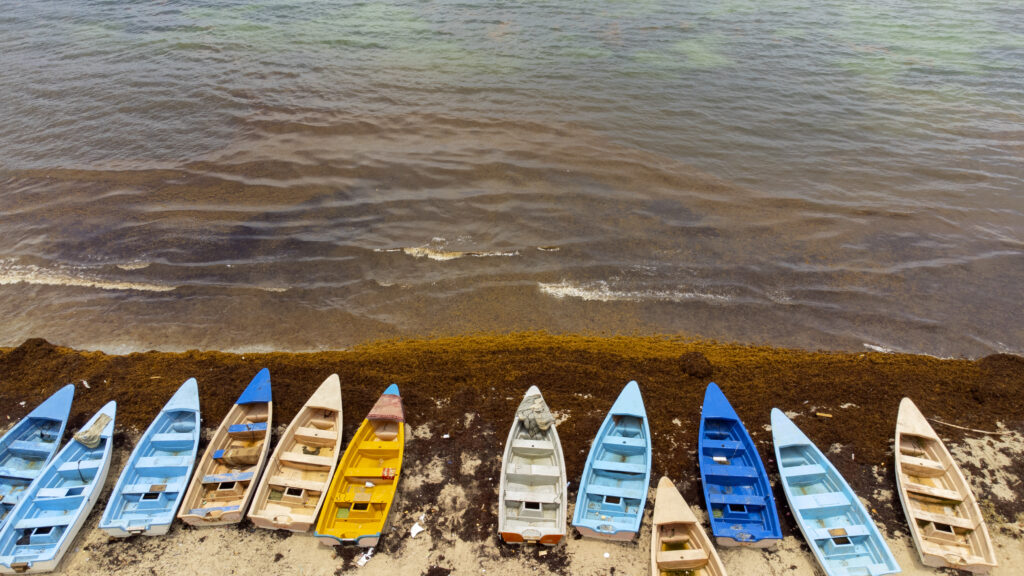
1. The Drunken Spring
The sea is feeling ill. Drunk on carbon, arsenic, nitrates. Instead of turquoise and transparent, it has a bilious, murky, sickly skin. The sea is dizzy and stumbles. Who put this island here? Kneeling on the white sand of the Caribbean, it expels tons of tangled algae mixed with garbage. Instead of leaves and stems, sargassum has blades and stipes; it lacks roots because it lives without a homeland, floating adrift; those little fraudulent grapes are vesicles filled with gas to avoid sinking.
The sea spits, relieves itself, and reintegrates, but here comes another heave. The vomit rots under the May sun. Flies proliferate, and tourists flee. A battalion of barefoot Sisyphuses spends the morning working to disguise this catastrophe. Poseidon’s trident would be useful for demolishing the mountain ranges of rancid salad that cover the beaches.
“Here come two foreigners.”
“They look like they’re crazy.”
One is taking photos of a pile of sargassum as if it were a supermodel in a bikini, posing for a tropical calendar. What is the other writing so much in his notebook? He acts as if the sea is holding a press conference.
“They’re surely on drugs.”
“Maybe they got confused and rolled a joint of sargassum.”
“I think so.”
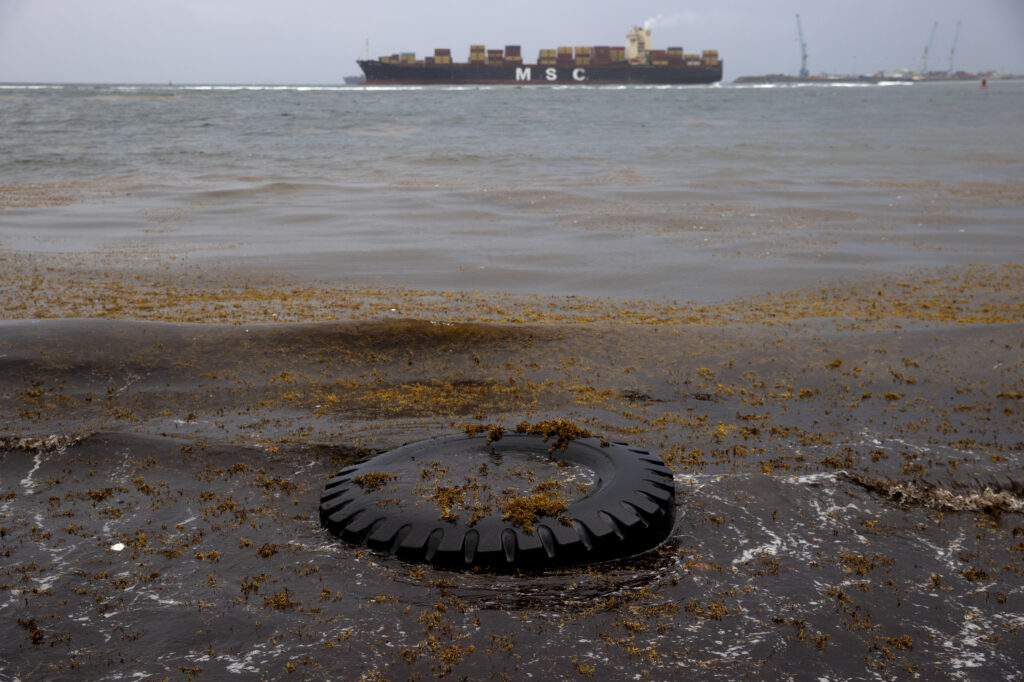
2. The Old Sea of Sargassum
On Sunday, September 16, 1492, the crew of La Niña, La Pinta, and the Santa María “began to see many herds of very green herb that seemed to have detached from land.” This is how Fray Bartolomé de Las Casas summarizes Christopher Columbus’s diary. That herb gave the admiral false hope; they were very far from land, at the eastern tip of the Sargasso Sea, a peaceful region of the North Atlantic where, since time immemorial, enormous meadows of pelagic macroalgae thrive.
September 17, 1492: “At dawn on that Monday, they saw many more herbs that seemed like river weeds, in which they found a live crab, which the Admiral kept.” That poor crab that Columbus caught is the first victim of the Western colonization of the New World. It probably belonged to the species Planes minutus, a perpetual navigator living in turtle shells, the hulls of ships, and sargassum islands.
Columbus’s diary is filled with “herb”: on September 29, “They saw much herb” and on the 30th “Four gannets were seen twice. Herb, a lot.” On October 2, the Admiral noted that the “herb was coming from east to west contrary to what was usual: many fish appeared; one was killed.” On the 8th, “The herb seemed very fresh; many little birds from the field, and one was caught fleeing to the Southwest, puffins and ducks and a gannet.” Then seaweed loses prominence. They come across the Indies, the people, and their villages. Sargassum returns until the return: on January 17, 1493, Columbus “saw much weed from what is on the sea.” On February 2: “They saw the sea so packed with herb that if they had not seen it [on the outbound journey], they would fear it was shallow.”
The Sargasso Sea was a stable zone of the Atlantic until, in 2009, the wild wind began to facilitate migrations. The flotillas of algae reached the North African coast and descended, carried by the Canary Islands current, to the North Equatorial current, which moves westward, propelled by the Earth’s rotation in the opposite direction.
Sargassum thrived in the sunny equator. At the beginning of 2011, the first waves arrived in the Caribbean. The world is changing, and this is one of its symptoms. A new grassy maelstrom form. The journal Science dubbed it the Great Atlantic Sargassum Belt.
Twelve years later, in May 2023, I arrive in the Dominican Republic to write this chronicle.
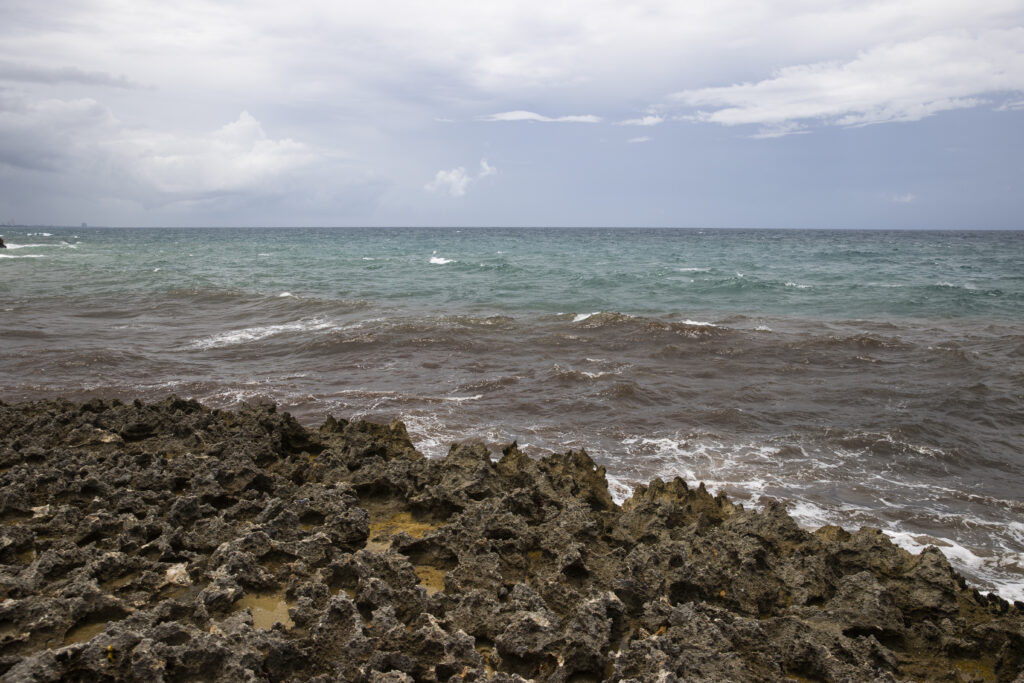
3. A Dangerous Mission
It’s 7:30 a.m. on Saturday, May 20, at the hotel restaurant. The background music sounds like something from a soft-porn movie. The scene, however, is far from erotic: photojournalist Orlando Barría and I are waiting for Radamés, a driver from the capital, with whom we’ll explore the beaches east of Santo Domingo. Besides a cup of espresso fuel, I ordered a green juice that, as it oxidized, looked like a seaweed smoothie (unfortunately, seaweed isn’t a good food option because it accumulates arsenic and other metals). Orlando is Chilean and has been in the Dominican Republic for many years. I ask him what kind of reports he usually covers. He tells me he’s covered, among other things, the war in Ukraine (where he lived through gunfire), Pope John Paul II’s visit to Cuba, and the 2010 earthquake in Haiti. He has worked many times in the neighboring country, the poorest and most troubled in the continent. A couple of years ago, he toured La Saline, a neighborhood in Port-au-Prince, with Jimmy Chérizier, alias “Barbecue,” leader of the G9 Fanmi, one of the armed groups fighting for power in Haiti. At the funeral of Jovenel Moïse, the president assassinated on July 7, 2021, shots were fired. “I almost got killed there,” he says in a tone that breaks the ice between two people who have just met. Compared to those experiences, our mission must seem more boring than a trip to the barber, where at least there are sharp scissors. Had I known, I would have tried to intimidate him by telling him that carnivorous bacteria of the Vibrio order have been discovered in seaweed, so our journey is like going in search of cannibals.
Everything fits on this island: at one end, the misery of the failed Haitian state; at the other, the opulence of Punta Cana, where hordes of millionaires come to indulge under the sun. In between is Caribbean life: centuries of good music and bad governance, the fragile prosperity of tourism, the precariousness of transportation and housing. There’s also ingenuity: a group of Dominican students recently won the Engineering Inspiration Award at the FIRST Robotics competition for developing «a reactor that generates fuel» from seaweed. The Santo Domingo Institute of Technology is also trying to use seaweed as organic fertilizer. In Mexico’s Caribbean, where seaweed has also become a huge problem, they’ve been using it to make construction bricks. While these initiatives are worth celebrating and supporting, the scattered and intermittent supply of raw material complicates the viability of these projects. That’s why I’m not too optimistic about the potential for capitalizing on this abundance. I hope I’m wrong, as I was when I thought Radamés had stood us up that morning.
4. The Sorcerer of Boca Chica and the Ghost of Playa Caribe
With a modest delay of an hour and a half, we leave the city. It’s pouring rain when we arrive at the tiny Playa de San Andrés to see the first accumulation of seaweed along the way. Less than a kilometer from the Santo Domingo Yacht Club, it looks like it snowed in the Caribbean: the seaweed is glazed with expanded polystyrene spheres. Tires in the sand form pools of poisonous broth. In the distance, the giant cranes of the cargo port complete the man-made landscape.
Ten minutes from this dystopia lies a paradisiacal corner. Boca Chica is protected from waves and seaweed by mangrove islets. Since it’s still early, there are hardly any visitors. A restaurateur approaches us to turn us into customers. We disappoint him by saying we’re on a journalistic mission. I try to ask him about the impacts of seaweed, but he clarifies that, aside from being a food entrepreneur, he’s a sorcerer, which guarantees him abundance and good luck. «First God, then me.» His neck is loaded with necklaces and amulets. With them, he protects himself from envy and supernatural attacks. He smokes a thick cigar. He tells us that on Mondays he goes to the cemetery to make deals with the great baron. He charges politicians and celebrities a fortune to summon him. Since my knowledge of Caribbean witchcraft is even worse than my knowledge of phycology, I assume the sorcerer’s partner is a man, when in fact it’s a baron with a capital B: the Baron of the cemetery is the first person buried there, a primogeniture that grants him magical powers.
We say goodbye to the sorcerer and move on. At the next beach we visit, there’s no seaweed either. I soak my feet purely for pleasure, and Orlando photographs a cute dog playing in the water alongside a couple of children.
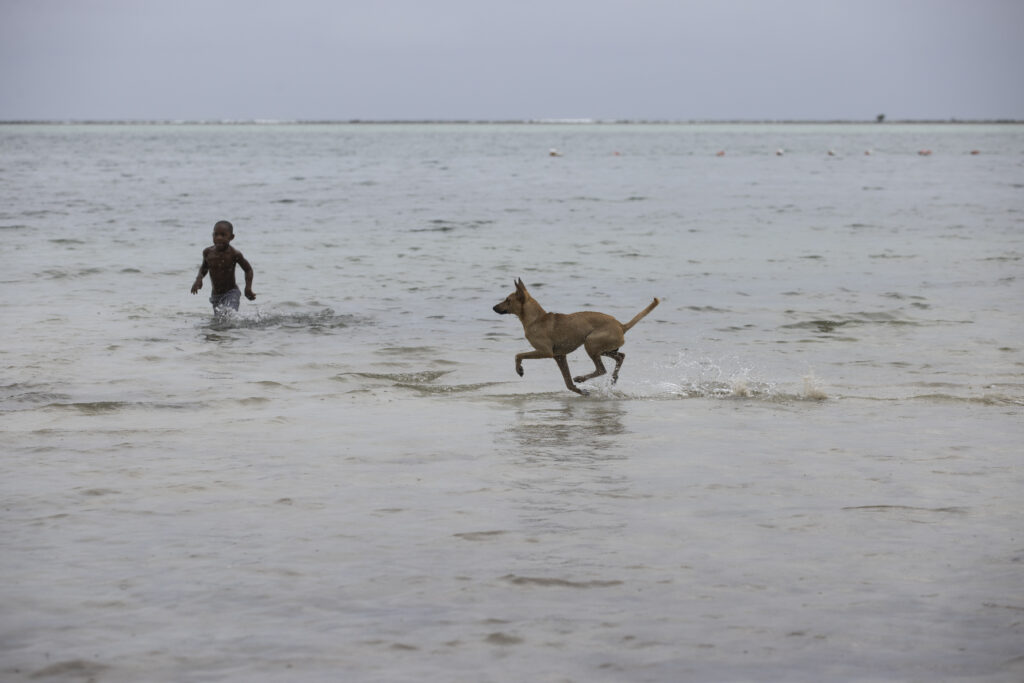
Frustrated by the lack of material for the story, we take the Eastern Highway. Radamés accelerates as we grow more impatient with the clean water in the area. Orlando and I keep our eyes on the waves. After a while, we finally spot a small bay pounded by chocolate-colored waves. I shout enthusiastically, as if I had just seen Pope John Paul II on a surfboard. Radamés brakes abruptly and reverses. For half a minute, we’re in an action movie.
The beach looks abandoned. There’s a run-down restaurant and a bunch of empty huts. Lots of weeds. The waves grind the seaweed against the rocky walls of the bay, making the sea murky. Squatting, I hear the murmur of tiny white flies. The breeze disperses the smell of decomposing matter. I walk into the water up to my knees. The sheets of seaweed are rougher than I expected, used to the softness of seaweed floating in miso soup. It’s like stepping into a pool full of dry leaves.
In the distance, I see a man fishing. I’m curious to ask him if the seaweed drives away the fish. We take a path filled with garbage (white polystyrene plates), and when we reach the end, he’s gone. I don’t understand how he disappeared without us seeing him. Confused by his vanishing, Orlando and I watch the rocks being pounded by the waves. It’s a hypnotic violence. It dominates the mind and relaxes it.
Back on the beach, we meet another man. His name is Alfredo. I tell him why we’re here. I turn on the recorder and ask him the name of this beautiful place. Playa Caribe. How do they deal with the seaweed? «On Wednesdays, the truck comes and takes it away. We, the people who work here, come and clean it up. There are twenty of us.» He’s laconic and slow. «We put it in wheelbarrows and sacks. We dig a hole and bury it, too.» The recording is full of the sound of waves and wind. «This beach is beautiful when it’s clean. People love to swim here, but like this, they can’t.» He clarifies that the seaweed is seasonal and that the beaches are clean the rest of the year. I ask if he knows of any other beaches affected. «In Guayacanes, there are hills of it. They’re using shovels over there. There’s a lot of it.» By “shovels,” he’s not referring to typical gardening or grave-digging tools, but to tractors with industrial backhoes, necessary to deal with tons of wet seaweed.

“I’m heading up there now,” he says as he gets on his motorcycle and speeds off toward the highway. Radamés starts the truck and steps on the gas to follow him.
5. The War: Drones and Submarines
The diver in Guayacanes asked me not to reveal his name or nickname. To conceal his identity, I must omit other colorful details from our conversation, which takes place surrounded by fishermen. There are no tourists on this beach either. Just fishing boats and mounds of seaweed, as Alfredo warned us.
The diver tells me they’ve resorted to collecting seaweed with rafts and nets to move it away from the coast. Unlike Alfredo, he’s very talkative. After describing the painful stings of the shark flea (“worse than a mosquito and an ant combined”), he asks if we’re biologists. «No,» I clarify, «journalists. He’s a photographer, and I’m a writer.»
“There’s another thing, and I hope you write about it because it’s really affecting fishing: the search for clams. The people looking for clams are destroying everything… Let’s suppose there’s a rock, and in that cave over there, that’s where the fish lay their eggs; if you come and destroy that, what happens? You take away their cave, and millions of fish are born there. It could be lobsters, octopuses. Most of them come to spawn here, close to shore. And it’s sacrilegious what they’re doing… Because in the past, clams were properly harvested. You’d search the sand with a knife and grab them. But not now. Now they tear apart the rocks, that’s abuse. You don’t see octopuses anymore, nothing. Without bait here, they don’t come… And this is where the fish spawn, snapper, everything spawns right here on the shore, and if there are no rocks, how will they grow before heading out to sea?”
I try to steer the conversation back to sargassum, asking if he believes it affects the marine ecosystem. «Of course! Because it heats up. If I had a mask, I’d take you down so you could see. The crabs, conch, and clams are all destroyed. Every time the sun heats the sargassum, it kills them. The conch dies, the octopus dies, the sardines die because the sargassum heats up like a stove. When the sun hits it, it warms the water, and the fish look for cooler water. Also, when it breaks down [sargassum is pulverized by the waves and dehydrated on the sand], the fine residue clogs the caves [he’s referring to the caves where fish take refuge]. The octopus, moray eels, they all flee from it. The sea drags it [the pulverized sargassum] down, it keeps falling, it blocks the caves. If the fish or the octopus are there, it blocks them too. On Thursday, I was at Juan Dolio [the next beach we’ll visit], looking for fish, and I saw a moray eel in a cave, but it was dead, its mouth full of that black sargassum. That sargassum destroys everything.»
He claims that the accumulation of sargassum has reduced the depth of the coastal sea. «And this,» he gestures to the beach, «has risen a lot because they bury so much of it to make it break down. They dug holes with machinery and buried tons of it. That’s less beach now, until a big storm comes along and washes it away.»
Having gained his trust, he shares his theory on the crisis: «Let me ask you something. Before, there wasn’t as much war, and there wasn’t so much sargassum. Now there’s war in some countries, and the sargassum keeps coming. What do they fight with? Submarines, right? And where are they? At the bottom. Every time one of those high-powered ships passes by, it stirs things up. It’s a crazy idea, but it came to me like that. I don’t know. Just a crazy idea from a Dominican diver. Imagine, a 160,000-ton ship, the propulsion it creates, and the sargassum is already semi-mature. Then submarines go through it… You get me? Imagine, every time a bomb or missile explodes, it’s at the bottom where they hit.»
Since he acknowledges that the hypothesis is a «crazy idea,» I don’t feel the need to challenge it and instead ask him how the situation has changed throughout his life. «It’s very different from when I was a kid. Even as an old crazy guy, I’ve noticed that the seasons are changing a lot… We are destroying our planet.»
As the diver mixes pearls of wisdom with outlandish ideas, Orlando flies a drone over the beach, taking aerial photos. This perspective reveals the full scale of the problem, with the coast covered in unhealthy matter. Instead of the usual white sand and turquoise water, we are faced with a range of colors from mustard yellow to charred black, with shades of excrement brown in between.
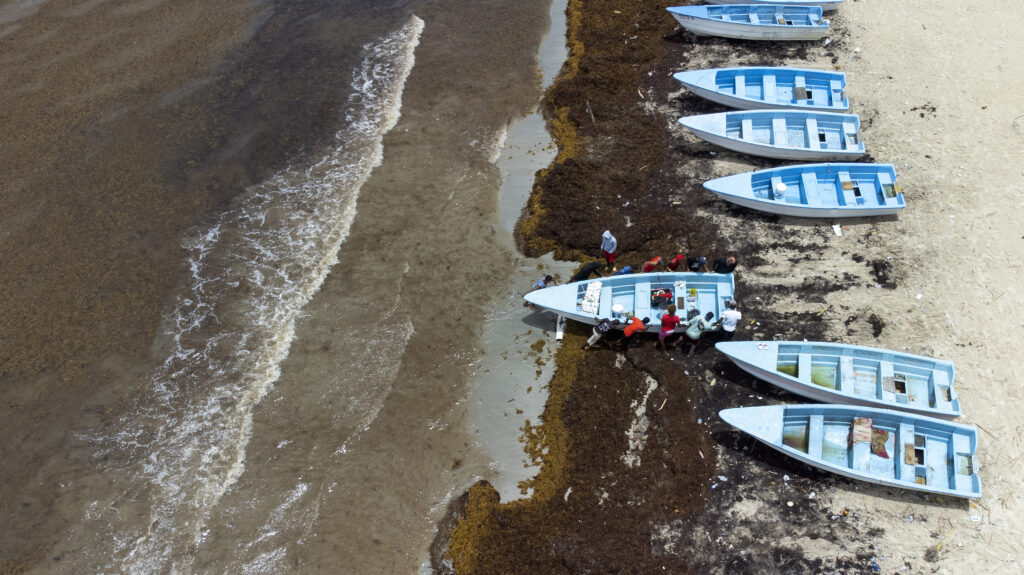
Unfortunately, there is no submarine capable of fighting the sargassum. The enemy has the Earth’s rotation, solar radiation in the tropical Atlantic, and rising carbon levels in the water and atmosphere on its side. It’s unclear how much the abundance of fertilizers carried by rivers on both sides of the ocean plays a role, or if the warming waters (which this year have reached unprecedented levels) help or hinder the algae’s reproduction. The Great Atlantic Sargassum Belt has existed for a decade and is only just beginning to be understood; it’s difficult to predict whether it will keep growing, stabilize, or shrink. Either way, its size necessitates international cooperation. Additionally, global warming presents other challenges to the Caribbean. In the short term, the most pressing is the intensification of hurricanes; in the long term, rising sea levels.
6. The Truce
We say goodbye to the diver and head to our final stop. Juan Dolio beach is packed with local swimmers. They play, swim, rest, and walk over the sargassum, seemingly indifferent. They came to have fun, not to give interviews. «You’re not from around here?» a young woman asks us. Her friend replies before we can: «They like brown skin.» I guess saying we’re working on a story doesn’t sound believable.
It’s time to leave. On the way to the truck, I stop by a log lying across the beach, where a dead fish rests on a bed of brown salad. A woman approaches and offers me her hand to help me over the obstacle. I smile and thank her. I may be skinny and clumsy, but not that much. In her other hand, she holds a plastic cup filled with fresh sargassum float vesicles. Embarrassed, I don’t ask what she plans to do with them. I suspect Columbus did the same. Along with the crab, he must have taken some of this «weed» too.
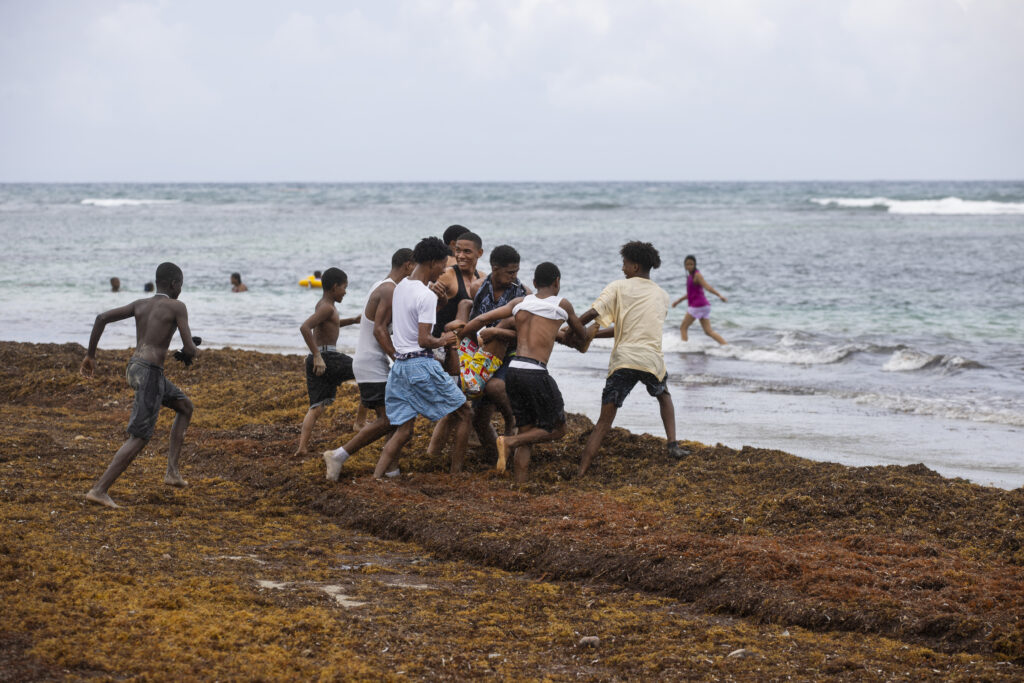
Credits
Text: Jorge Comensal
Photography: Orlando Barría
Curation and Editing: Emiliano Monge
Centroamérica Cuenta | Dominican Republic, may 2023

